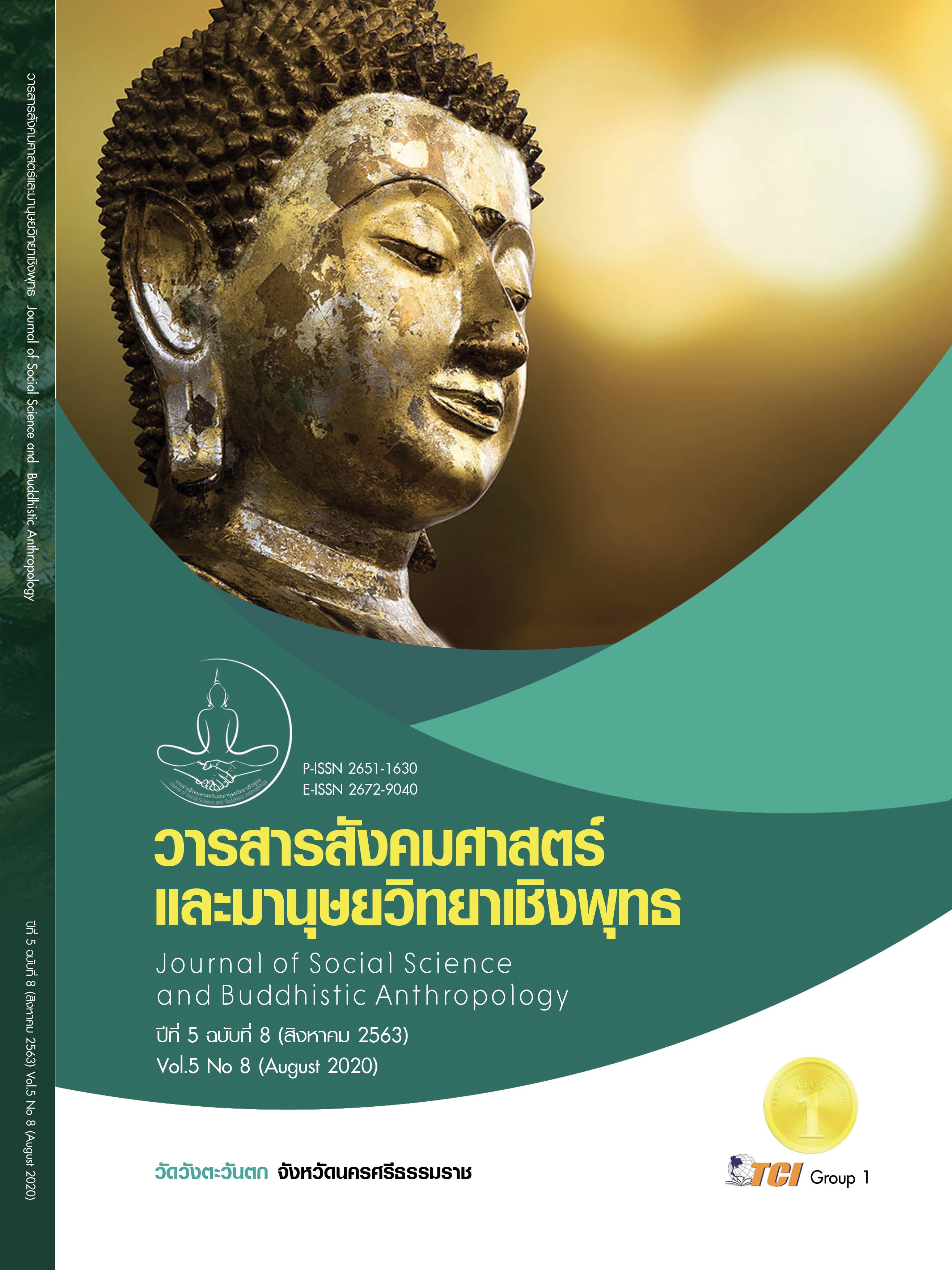THE APPLICATION OF POSTMODERN PHILOSOPHY AND BUDDHIST PHILOSOPHY FOR PROPAGATING THE BUDDHIST TEACHING IN THE DIGITAL SOCIETY
Keywords:
Application, Postmodern Philosophy, Buddhist Philosophy, Propagating of Buddhist Teaching, Digital SocietyAbstract
This article is intended: 1) to study the theoretical concepts related with the propagating of Buddhist teaching, 2) to study the postmodern philosophy and Buddhist philosophy concerning with propagating of Buddhist teaching, 3) to apply the postmodern philosophy and Buddhist philosophy as a guideline for problem solving and propagating of Buddhist teaching. and 4) to create new knowledge and the propagation model of Buddhist teaching. This research is qualitative research by analyzing documents and semi-structured interview purposive selection methods. The source of primary data was 10 monks who work to propagating Buddhist principles in the digital age by analyzing the content and summary. The results of research are found as follows: 1) the theoretical propagating concepts, such as propagation of Buddhist principles, to communicate about problems of Thai society in the digital age and propagation problem for the monks at present. 2) The postmodern philosophy and Buddhist philosophy such as 2.1) the philosophy after postmodern including with Michel Foucault 2.2) language philosophy including with spoken language, written language, signal language and reasoning language and 2.3) Buddhist philosophy including with 2.3.1) Buddhist metaphysics such as Khun 5 (Five Aggregates) Tilakkhana (Three Common Characteristics) and Paticca Samuppada (Dependent Origination) 2.3.2) Buddhist Epistemology including with Punya 3 (Wisdom) and Kalama Sutra (Reasonable) and 2.3.3) Buddhist Ethic such as The Noble Eightfold Path and Tisikkha (Threefold Training). 3) Applying to solve problems such as time limited of the sermon, inexperienced, lacks of media knowledge, lacks of deep understanding moral, lacks of new modern language knowledge and lacks of social change understanding and 4) The new knowledge was Active Buddhist Missionary encourage and proactively driven, lead the process and management mechanisms to create awareness organizations Pariyatti Dhamma (To study Buddhist Scriptures), Patipatti Dhamma (practice the dharma), Patiwetha Dhamma (understand thoroughly) by constructive implement on digital media.
References
กีรติ บุญเจือ. (2545). ปรัชญาหลังนวยุค. กรุงเทพมหานคร: ดวงกมล.
บุญชม ศรีสะอาด. (2556). วิธีการทางสถิติสำหรับการวิจัย เล่ม 1. (พิมพ์ครั้งที่ 5). กรุงเทพมหานคร: สุวีริยาการพิมพ์.
พระครูปลัดพลกฤต กลฺยาณธมฺโม. (19 มกราคม 2563). การแก้ปัญหาการเผยแผ่หลักพุทธธรรมของพระสงฆ์ในสังคมยุคดิจิทัล. (พระปลัดเมธี ปิยธมฺโม (หินใหม่), ผู้สัมภาษณ์)
พระครูวาทีพัชรโสภณ (พระครูปลัดราชันย์ อริโย). (24 มกราคม 2563). การแก้ปัญหาการเผยแผ่หลักพุทธธรรมของพระสงฆ์ในสังคมยุคดิจิทัล. (พระปลัดเมธี ปิยธมฺโม (หินใหม่), ผู้สัมภาษณ์)
พระครูวิจิตรศีลาจาร (ประสิทธิ์ ชาตวณฺโณ). (19 มกราคม 2563). การแก้ปัญหาการเผยแผ่หลักพุทธธรรมของพระสงฆ์ในสังคมยุคดิจิทัล. (พระปลัดเมธี ปิยธมฺโม (หินใหม่), ผู้สัมภาษณ์)
พระครูวินัยธรกิตติศักดิ์ โคตรมสิสฺโส (ศ.สียวน). (24 มกราคม 2563). การแก้ปัญหาการเผยแผ่หลักพุทธธรรมของพระสงฆ์ในสังคมยุคดิจิทัล. (พระปลัดเมธี ปิยธมฺโม (หินใหม่), ผู้สัมภาษณ์)
พระไพศาล วิสาโล. (2562). การปฏิรูปและฟื้นฟูพุทธศาสนาในยุคโลกาภิวัตน์. เรียกใช้เมื่อ 19 มิถุนายน 2562 จาก http://www.buddhadasa.org.
พระมหาธนิต สิริวฒฺฑโน. (2558). รูปแบบและกระบวนการสื่อสารพุทธธรรม. วารสารวิจัย ราชภัฏเชียงใหม่, 16(2), 97-105.
พระมหาสมชาย กลิ่นจันทร์. (2559). การเผยแผ่พระพุทธศาสนา: การพัฒนารูปแบบและวิธีการเชิงรุกของคณะสงฆ์ไทยจังหวัดเชียงใหม่. วารสารบัณฑิตศึกษาปริทรรศน์, 12(3), 1-14.
พระมหาสมปอง ตาลปุตฺโต (นครไธสง). (20 มกราคม 2563). การแก้ปัญหาการเผยแผ่หลักพุทธธรรมของพระสงฆ์ในสังคมยุคดิจิทัล. (พระปลัดเมธี ปิยธมฺโม (หินใหม่), ผู้สัมภาษณ์)
พระรัตนมุนี (ปุณณมี วิสารโท). (2561). การพัฒนารูปแบบการประยุกต์ใช้หลักพุทธธรรมในการพัฒนาสังคม. วารสาร มจร สังคมศาสตร์ปริทรรศน์, 7(2), 1-15.
พิชัย สุขวุ่น. (2558). กระบวนทรรศน์หลังนวยุคในปรัชญาศิลปะของท่านพุทธทาสภิกขุ: การศึกษาเชิงวิเคราะห์ วิจักษ์ และวิธาน. ใน ดุษฎีนิพนธ์ปรัชญาดุษฎีบัณฑิต สาขาปรัชญาและจริยศาสตร์. มหาวิทยาลัยราชภัฏสวนสุนันทา.
ภัทรวรรณ วันทนชัยสุข. (2562). ความรู้เกี่ยวกับพระพุทธเจ้า. เรียกใช้เมื่อ 9 มิถุนายน 2562 จาก www.phuttha.com/พระพุทธเจ้า/ความรู้เกี่ยวกับพระพุทธเจ้า
วีรณัฐ โรจนประภา. (2562). การนำกระบวนทรรศน์ปรัชญาหลังนวยุค และพุทธปรัชญามาสร้างสังคมแห่งสัมมาปัญญาในประเทศไทย 4.0. วารสารวิชาการเซนต์จอห์น, 22(30), 1-15.
สวัสดิ์ อโณทัย. (2558). วิธีการสร้างความสุขตามปรัชญาเศรษฐกิจพอเพียง. วารสารวิชาการเซนต์จอห์น, 18(22), 161-177.
Berman, M. (1982). All That is Solid Melts into Air: The Experience of Modernity. New York: Penguin Book.
Brandbuffet. (2563). สถิติผู้ใช้ดิจิทัลทั่วโลก “ไทย” เสพติดเน็ตมากสุดในโลก “กรุงเทพ” เมืองผู้ใช้ Facebook สูงสุด. เรียกใช้เมื่อ 14 เมษายน 2563 จาก https://www.brandbuffet.in.th/2018/02/ global-and-thailand-digital-report-2018
Cronbach, L. J. (1990). Essentials of psychological testing. (5th ed.). New York: Harpercollins. Publishers.
Phramaha Boonthai Punyamano. (2019). The Study of Buddhism in 21st Century. Retrieved October 19 , 2019, from http://www.phd.mbu.ac.th/index.php








